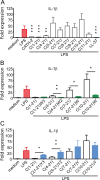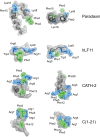Immunomodulatory and Anti-Inflammatory Activities of Chicken Cathelicidin-2 Derived Peptides
- PMID: 26848845
- PMCID: PMC4743981
- DOI: 10.1371/journal.pone.0147919
Immunomodulatory and Anti-Inflammatory Activities of Chicken Cathelicidin-2 Derived Peptides
Abstract
Host Defence Peptides and derived peptides are promising classes of antimicrobial and immunomodulatory lead compounds. For this purpose we examined whether chicken cathelicidin-2 (CATH-2)-derived peptides modulate the function and inflammatory response of avian immune cells. Using a chicken macrophage cell line (HD11) we found that full-length CATH-2 dose-dependently induced transcription of chemokines CXCLi2/IL-8, MCP-3 and CCLi4/RANTES, but not of pro-inflammatory cytokine IL-1β. In addition, CATH-2 efficiently inhibited IL-1β and nitric oxide production by HD11 cells induced by different sources of lipopolysaccharides (LPS). N-terminal truncated CATH-2 derived peptides maintained the capacity to selectively induce chemokine transcription, but despite their high LPS affinity several analogs lacked LPS-neutralizing capacity. Substitution of phenylalanine residues by tryptophan introduced endotoxin neutralization capacity in inactive truncated CATH-2 derived peptides. In contrast, amino acid substitution of phenylalanine by tyrosine abrogated endotoxin neutralization activity of CATH-2 analogs. These findings support a pivotal role for aromatic residues in peptide-mediated endotoxin neutralization by CATH-2 analogs and were shown to be independent of LPS affinity. The capacity to modulate chemokine production and dampen endotoxin-induced pro-inflammatory responses in chicken immune cells implicates that small CATH-2 based peptides could serve as leads for the design of CATH-2 based immunomodulatory anti-infectives.
Conflict of interest statement
Figures







Similar articles
-
Chicken CATH-2 Increases Antigen Presentation Markers on Chicken Monocytes and Macrophages.Protein Pept Lett. 2020;27(1):60-66. doi: 10.2174/0929866526666190730125525. Protein Pept Lett. 2020. PMID: 31362652 Free PMC article.
-
Identification of chicken cathelicidin-2 core elements involved in antibacterial and immunomodulatory activities.Mol Immunol. 2009 Aug;46(13):2465-73. doi: 10.1016/j.molimm.2009.05.019. Epub 2009 Jun 12. Mol Immunol. 2009. PMID: 19524300
-
Tree Frog-Derived Cathelicidin Protects Mice against Bacterial Infection through Its Antimicrobial and Anti-Inflammatory Activities and Regulatory Effect on Phagocytes.ACS Infect Dis. 2023 Nov 10;9(11):2252-2268. doi: 10.1021/acsinfecdis.3c00316. Epub 2023 Oct 19. ACS Infect Dis. 2023. PMID: 37855266
-
Peptides with dual mode of action: Killing bacteria and preventing endotoxin-induced sepsis.Biochim Biophys Acta. 2016 May;1858(5):971-9. doi: 10.1016/j.bbamem.2016.01.011. Epub 2016 Jan 20. Biochim Biophys Acta. 2016. PMID: 26801369 Review.
-
Comparison of in vitro tests for antioxidant and immunomodulatory capacities of compounds.Phytomedicine. 2014 Jan 15;21(2):164-71. doi: 10.1016/j.phymed.2013.08.008. Epub 2013 Sep 14. Phytomedicine. 2014. PMID: 24041614 Review.
Cited by
-
Chicken CATH-2 Increases Antigen Presentation Markers on Chicken Monocytes and Macrophages.Protein Pept Lett. 2020;27(1):60-66. doi: 10.2174/0929866526666190730125525. Protein Pept Lett. 2020. PMID: 31362652 Free PMC article.
-
Effects of Escherichia coli LPS Structure on Antibacterial and Anti-Endotoxin Activities of Host Defense Peptides.Pharmaceuticals (Basel). 2023 Oct 18;16(10):1485. doi: 10.3390/ph16101485. Pharmaceuticals (Basel). 2023. PMID: 37895956 Free PMC article.
-
Immunomodulation and effects on microbiota after in ovo administration of chicken cathelicidin-2.PLoS One. 2018 Jun 5;13(6):e0198188. doi: 10.1371/journal.pone.0198188. eCollection 2018. PLoS One. 2018. PMID: 29870564 Free PMC article.
-
In vitro Impact of Yeast Expressed Hybrid Peptide CATH-2TP5 as a Prophylactic Measure Toward Sepsis and Inflammation.Front Bioeng Biotechnol. 2020 Jun 3;8:454. doi: 10.3389/fbioe.2020.00454. eCollection 2020. Front Bioeng Biotechnol. 2020. PMID: 32582649 Free PMC article.
-
Macrophage Activation Assays to Evaluate the Immunostimulatory Capacity of Avibacterium paragallinarum in A Multivalent Poultry Vaccine.Vaccines (Basel). 2020 Nov 10;8(4):671. doi: 10.3390/vaccines8040671. Vaccines (Basel). 2020. PMID: 33182624 Free PMC article.
References
-
- Li X, Mehrotra M, Ghimire S, Adewoye L. β-Lactam resistance and β-lactamases in bacteria of animal origin. Vet Mic. 2007;121:197–214. - PubMed
-
- Hancock REW. Mechanisms of action of newer antibiotics for Gram-positive pathogens. Lancet Infect Dis. 2005;5:209–218. - PubMed
-
- Peschel A, Sahl HG. The co-evolution of host cationic antimicrobial peptides and microbial resistance. Nat Rev Microbiol. 2006;4:529–536. - PubMed
Publication types
MeSH terms
Substances
LinkOut - more resources
Full Text Sources
Other Literature Sources
Miscellaneous

